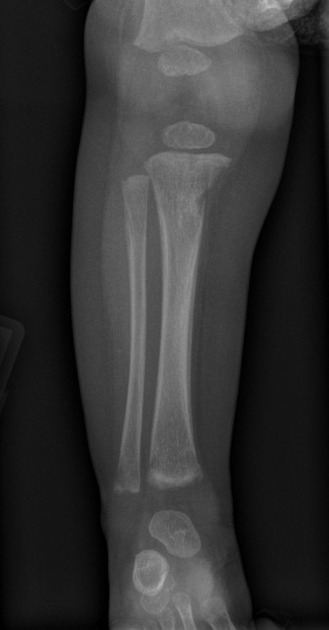Presentation
Newborn infant presents with a five day history of fussiness and decreased movement of the extremities. Physical exam reveals no swelling or fever; laboratory evaluation reveals leukocytosis and elevated inflammatory markers.
Patient Data

Skeletal survey was performed. This revealed metaphyseal destruction at the right medial proximal tibia, also known as the Wimberger sign, which is pathognomonic for congenital syphilis. Also noted is periosteal reaction along the tibial shaft.
Case Discussion
Congenital syphilis occurs via in utero transplacental transmission of the bacterial spirochete Treponema pallidum. Transmission occurs in approximately one-third of cases of maternal syphilis. Clinical presentation may be extremely varied, due to diffuse dissemination of the spirochete throughout the fetus. This is particularly true before the age of two years, though presentation rarely presents antenatally or at birth.
Early presentations include musculoskeletal anomalies, as above, in addition to neurosyphilis (acute leptomeningitis and chronic hydrocephalus), hepatosplenomegaly, ascites, jaundice, and diffuse lymphadenopathy, among other findings.
Late presentation is more predicable and classic, characterized by the Hutchinson triad of neurosyphilis (sensorineural deafness), craniofacial/dental anomalies (frontal bossing, saddle nose, Hutchinson teeth, and hard palate perforation), and keratitis. Early detection and prompt treatment with benzathine penicillin G can prevent some, but not all, of the later manifestations of congenital syphilis.




 Unable to process the form. Check for errors and try again.
Unable to process the form. Check for errors and try again.